Pizza Hut: Brand Loyalty and Customer Perception Analysis
VerifiedAdded on 2023/06/12
|16
|4176
|222
Case Study
AI Summary
This case study explores the relationship between brand and customer perception within the fast food industry, specifically focusing on Pizza Hut. It delves into factors influencing brand loyalty, including brand reliability, customer-based model of brand equity, and the impact of brand social responsibility image (BSRI). The study examines the role of brand loyalty in the fast food sector, considering the influence of promotional activities, product quality, and brand name on consumer behavior. Research questions address the significance of brand reliability, its presence among corporate entities and customers, and its impact on fast food chains like Pizza Hut. The research uses a hypothesis to determine if positive implications are depicted concerning brand loyalty between Pizza Hut and its customers. This study is a comprehensive analysis of the multifaceted elements that contribute to brand loyalty and customer perception in the competitive fast food market.

Running head: IMPACT OF BRAND ON CUSTOMER PERCEPTION OF FAST FOOD
Impact of Brand on Customer Perception of Fast Food - Case Study of Pizza Hut
Name of Student:
Name of University:
Author’s Note:
Impact of Brand on Customer Perception of Fast Food - Case Study of Pizza Hut
Name of Student:
Name of University:
Author’s Note:
Paraphrase This Document
Need a fresh take? Get an instant paraphrase of this document with our AI Paraphraser

1
IMPACT OF BRAND ON CUSTOMER PERCEPTION OF FAST FOOD
Table of Contents
1.0 Introduction:..............................................................................................................................2
1.1 Working Title:...................................................................................................................2
1.2 Background of the study...................................................................................................2
1.3 Rationale of the study.......................................................................................................3
1.4 Aims and objectives of the research.................................................................................3
1.4.1 Aims of the research..................................................................................................3
1.4.2 Research Objectives...................................................................................................3
1.5 Research questions.................................................................................................................4
1.6 Research hypothesis...............................................................................................................4
3.0 Research design and Methodology:...........................................................................................9
3.1 Research onion:...................................................................................................................10
3.2 Research Philosophy:...........................................................................................................10
3.3 Research approach:..............................................................................................................11
3.5 Sampling method:................................................................................................................11
3.8 Key issue of data collection:................................................................................................12
3.9 Data analysis:.......................................................................................................................12
3.10 Ethical issue:......................................................................................................................12
3.11 Gantt Chart:.......................................................................................................................12
3.11 Gantt Chart:.......................................................................................................................12
References......................................................................................................................................14
IMPACT OF BRAND ON CUSTOMER PERCEPTION OF FAST FOOD
Table of Contents
1.0 Introduction:..............................................................................................................................2
1.1 Working Title:...................................................................................................................2
1.2 Background of the study...................................................................................................2
1.3 Rationale of the study.......................................................................................................3
1.4 Aims and objectives of the research.................................................................................3
1.4.1 Aims of the research..................................................................................................3
1.4.2 Research Objectives...................................................................................................3
1.5 Research questions.................................................................................................................4
1.6 Research hypothesis...............................................................................................................4
3.0 Research design and Methodology:...........................................................................................9
3.1 Research onion:...................................................................................................................10
3.2 Research Philosophy:...........................................................................................................10
3.3 Research approach:..............................................................................................................11
3.5 Sampling method:................................................................................................................11
3.8 Key issue of data collection:................................................................................................12
3.9 Data analysis:.......................................................................................................................12
3.10 Ethical issue:......................................................................................................................12
3.11 Gantt Chart:.......................................................................................................................12
3.11 Gantt Chart:.......................................................................................................................12
References......................................................................................................................................14

2
IMPACT OF BRAND ON CUSTOMER PERCEPTION OF FAST FOOD
1.0 Introduction:
1.1 Working Title:
“The relationship between the brand and customer in the food industry- Pizza Hut”.
1.2 Background of the study
The competitive market has been identified with securing long-term profitability which
leads to focusing on the long-term profitability. It has been seen that business corporations
are now focusing on creating a brand loyalty which can aid in supporting the development of
delightful and loyal customer base. The amount of the brand loyalty is seen to be depicted in
the form of the customer's informed decision related to the frequent purchases (Anselmsson,
Vestman Bondesson and Johansson 2014).
It needs to be further discerned that the loyal customers are not only able to reflect the
intent of purchase but also their psychological dedication towards a brand. Henceforth, the
business organisation are depicted to incorporate several types of the brand loyalty programs
and promotional techniques such as offering the gift, rebates, promotional methods and credit
cards (co-branded). It needs to be also noted that the business organisations incorporate the
external cues of the brand including the "design, value and performance". The main aspects
of the research have been able to focus on the trend of the market which is depicted regarding
the globally emerging fast food chains.
The increasing nature of the differential price range, competition along with
environmental volatility has led to the increased competition. The growing concern for the
business in the recent time is seen with the factors which affect customer loyalty and interest
towards a brand (Lassoued and Hobbs 2015).
The procedure for establishing “customer loyalty” is understood with responding
to the requirement of the customer which is decisive and indispensable in the way a business
operates. It needs to be also understood that brand loyalty is seen to be encompassed with
essential factors for the business corporation which can improve the customer retention
which puts a constructive impact on the revenue generation. Regarding the present
background, the various facets of the study aim to perceive the brand and measurement of the
IMPACT OF BRAND ON CUSTOMER PERCEPTION OF FAST FOOD
1.0 Introduction:
1.1 Working Title:
“The relationship between the brand and customer in the food industry- Pizza Hut”.
1.2 Background of the study
The competitive market has been identified with securing long-term profitability which
leads to focusing on the long-term profitability. It has been seen that business corporations
are now focusing on creating a brand loyalty which can aid in supporting the development of
delightful and loyal customer base. The amount of the brand loyalty is seen to be depicted in
the form of the customer's informed decision related to the frequent purchases (Anselmsson,
Vestman Bondesson and Johansson 2014).
It needs to be further discerned that the loyal customers are not only able to reflect the
intent of purchase but also their psychological dedication towards a brand. Henceforth, the
business organisation are depicted to incorporate several types of the brand loyalty programs
and promotional techniques such as offering the gift, rebates, promotional methods and credit
cards (co-branded). It needs to be also noted that the business organisations incorporate the
external cues of the brand including the "design, value and performance". The main aspects
of the research have been able to focus on the trend of the market which is depicted regarding
the globally emerging fast food chains.
The increasing nature of the differential price range, competition along with
environmental volatility has led to the increased competition. The growing concern for the
business in the recent time is seen with the factors which affect customer loyalty and interest
towards a brand (Lassoued and Hobbs 2015).
The procedure for establishing “customer loyalty” is understood with responding
to the requirement of the customer which is decisive and indispensable in the way a business
operates. It needs to be also understood that brand loyalty is seen to be encompassed with
essential factors for the business corporation which can improve the customer retention
which puts a constructive impact on the revenue generation. Regarding the present
background, the various facets of the study aim to perceive the brand and measurement of the
⊘ This is a preview!⊘
Do you want full access?
Subscribe today to unlock all pages.

Trusted by 1+ million students worldwide
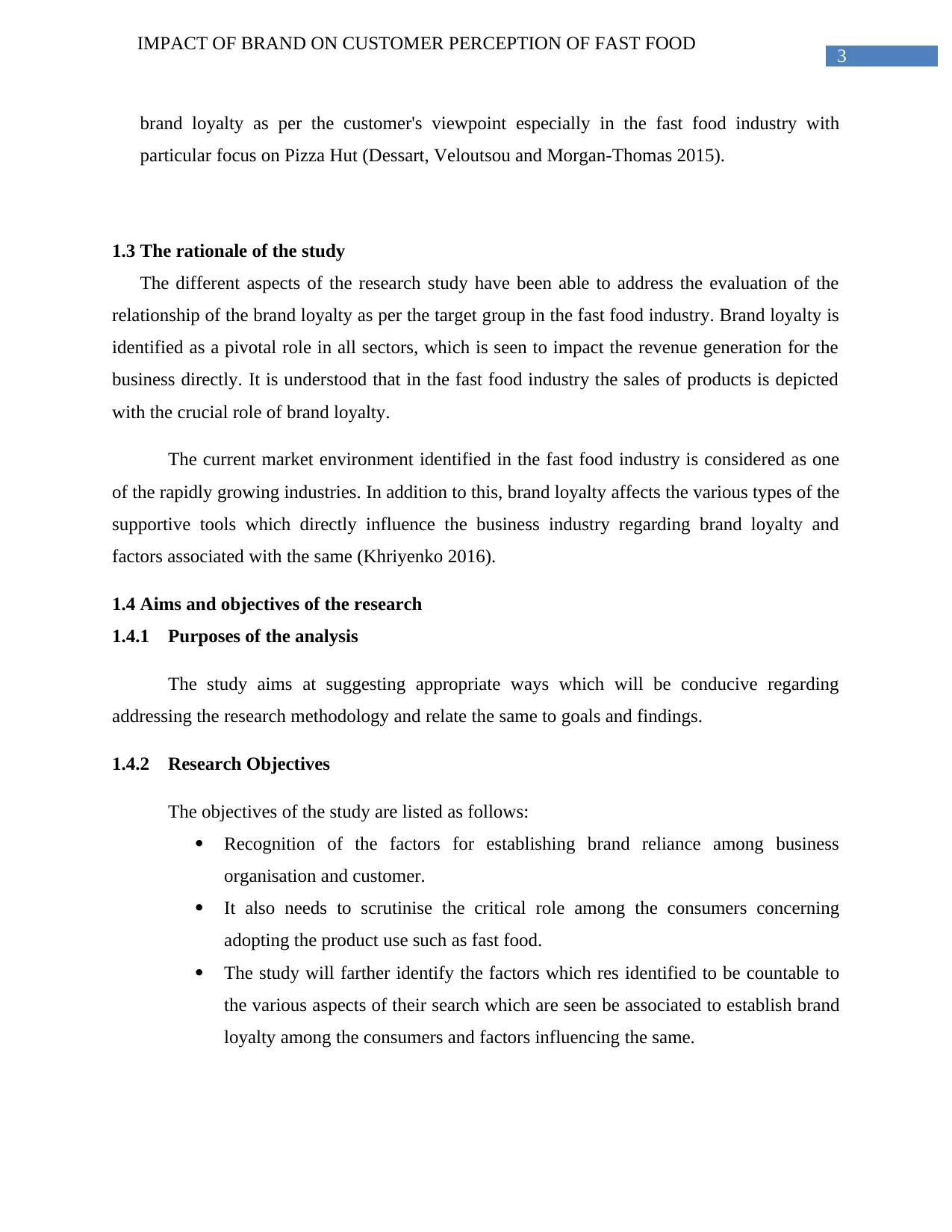
3
IMPACT OF BRAND ON CUSTOMER PERCEPTION OF FAST FOOD
brand loyalty as per the customer's viewpoint especially in the fast food industry with
particular focus on Pizza Hut (Dessart, Veloutsou and Morgan-Thomas 2015).
1.3 The rationale of the study
The different aspects of the research study have been able to address the evaluation of the
relationship of the brand loyalty as per the target group in the fast food industry. Brand loyalty is
identified as a pivotal role in all sectors, which is seen to impact the revenue generation for the
business directly. It is understood that in the fast food industry the sales of products is depicted
with the crucial role of brand loyalty.
The current market environment identified in the fast food industry is considered as one
of the rapidly growing industries. In addition to this, brand loyalty affects the various types of the
supportive tools which directly influence the business industry regarding brand loyalty and
factors associated with the same (Khriyenko 2016).
1.4 Aims and objectives of the research
1.4.1 Purposes of the analysis
The study aims at suggesting appropriate ways which will be conducive regarding
addressing the research methodology and relate the same to goals and findings.
1.4.2 Research Objectives
The objectives of the study are listed as follows:
Recognition of the factors for establishing brand reliance among business
organisation and customer.
It also needs to scrutinise the critical role among the consumers concerning
adopting the product use such as fast food.
The study will farther identify the factors which res identified to be countable to
the various aspects of their search which are seen be associated to establish brand
loyalty among the consumers and factors influencing the same.
IMPACT OF BRAND ON CUSTOMER PERCEPTION OF FAST FOOD
brand loyalty as per the customer's viewpoint especially in the fast food industry with
particular focus on Pizza Hut (Dessart, Veloutsou and Morgan-Thomas 2015).
1.3 The rationale of the study
The different aspects of the research study have been able to address the evaluation of the
relationship of the brand loyalty as per the target group in the fast food industry. Brand loyalty is
identified as a pivotal role in all sectors, which is seen to impact the revenue generation for the
business directly. It is understood that in the fast food industry the sales of products is depicted
with the crucial role of brand loyalty.
The current market environment identified in the fast food industry is considered as one
of the rapidly growing industries. In addition to this, brand loyalty affects the various types of the
supportive tools which directly influence the business industry regarding brand loyalty and
factors associated with the same (Khriyenko 2016).
1.4 Aims and objectives of the research
1.4.1 Purposes of the analysis
The study aims at suggesting appropriate ways which will be conducive regarding
addressing the research methodology and relate the same to goals and findings.
1.4.2 Research Objectives
The objectives of the study are listed as follows:
Recognition of the factors for establishing brand reliance among business
organisation and customer.
It also needs to scrutinise the critical role among the consumers concerning
adopting the product use such as fast food.
The study will farther identify the factors which res identified to be countable to
the various aspects of their search which are seen be associated to establish brand
loyalty among the consumers and factors influencing the same.
Paraphrase This Document
Need a fresh take? Get an instant paraphrase of this document with our AI Paraphraser
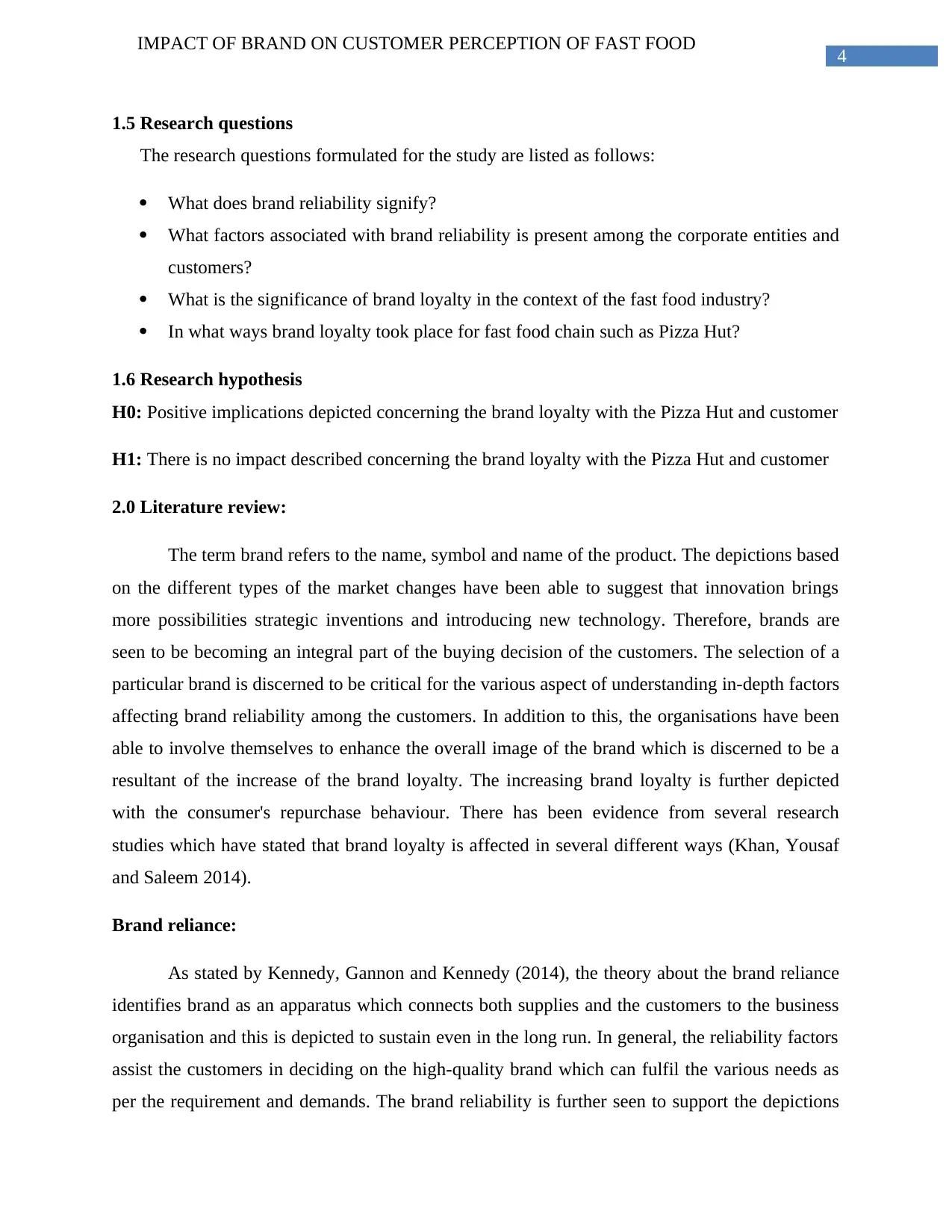
4
IMPACT OF BRAND ON CUSTOMER PERCEPTION OF FAST FOOD
1.5 Research questions
The research questions formulated for the study are listed as follows:
What does brand reliability signify?
What factors associated with brand reliability is present among the corporate entities and
customers?
What is the significance of brand loyalty in the context of the fast food industry?
In what ways brand loyalty took place for fast food chain such as Pizza Hut?
1.6 Research hypothesis
H0: Positive implications depicted concerning the brand loyalty with the Pizza Hut and customer
H1: There is no impact described concerning the brand loyalty with the Pizza Hut and customer
2.0 Literature review:
The term brand refers to the name, symbol and name of the product. The depictions based
on the different types of the market changes have been able to suggest that innovation brings
more possibilities strategic inventions and introducing new technology. Therefore, brands are
seen to be becoming an integral part of the buying decision of the customers. The selection of a
particular brand is discerned to be critical for the various aspect of understanding in-depth factors
affecting brand reliability among the customers. In addition to this, the organisations have been
able to involve themselves to enhance the overall image of the brand which is discerned to be a
resultant of the increase of the brand loyalty. The increasing brand loyalty is further depicted
with the consumer's repurchase behaviour. There has been evidence from several research
studies which have stated that brand loyalty is affected in several different ways (Khan, Yousaf
and Saleem 2014).
Brand reliance:
As stated by Kennedy, Gannon and Kennedy (2014), the theory about the brand reliance
identifies brand as an apparatus which connects both supplies and the customers to the business
organisation and this is depicted to sustain even in the long run. In general, the reliability factors
assist the customers in deciding on the high-quality brand which can fulfil the various needs as
per the requirement and demands. The brand reliability is further seen to support the depictions
IMPACT OF BRAND ON CUSTOMER PERCEPTION OF FAST FOOD
1.5 Research questions
The research questions formulated for the study are listed as follows:
What does brand reliability signify?
What factors associated with brand reliability is present among the corporate entities and
customers?
What is the significance of brand loyalty in the context of the fast food industry?
In what ways brand loyalty took place for fast food chain such as Pizza Hut?
1.6 Research hypothesis
H0: Positive implications depicted concerning the brand loyalty with the Pizza Hut and customer
H1: There is no impact described concerning the brand loyalty with the Pizza Hut and customer
2.0 Literature review:
The term brand refers to the name, symbol and name of the product. The depictions based
on the different types of the market changes have been able to suggest that innovation brings
more possibilities strategic inventions and introducing new technology. Therefore, brands are
seen to be becoming an integral part of the buying decision of the customers. The selection of a
particular brand is discerned to be critical for the various aspect of understanding in-depth factors
affecting brand reliability among the customers. In addition to this, the organisations have been
able to involve themselves to enhance the overall image of the brand which is discerned to be a
resultant of the increase of the brand loyalty. The increasing brand loyalty is further depicted
with the consumer's repurchase behaviour. There has been evidence from several research
studies which have stated that brand loyalty is affected in several different ways (Khan, Yousaf
and Saleem 2014).
Brand reliance:
As stated by Kennedy, Gannon and Kennedy (2014), the theory about the brand reliance
identifies brand as an apparatus which connects both supplies and the customers to the business
organisation and this is depicted to sustain even in the long run. In general, the reliability factors
assist the customers in deciding on the high-quality brand which can fulfil the various needs as
per the requirement and demands. The brand reliability is further seen to support the depictions

5
IMPACT OF BRAND ON CUSTOMER PERCEPTION OF FAST FOOD
which influence customers for opting the right product and brands identified with a specified
product or service. The main pieces of evidence taken from the previous research support to
discourse which states that there is affluent work being carried out by the marketers on the
edifice and maintaining brand reliance. In addition to this, there is a noticeable development in
the facts about the brand loyalty (Hill et al. 2015).
During the research, there have been several research studies which can suggest that the
frameworks and models associated with the identify the impact of brand reliability from various
perspectives on the consumer behaviour. In this particular consideration “customer-based model
of brand equity” has depicted several notions of the decision-making process by the consumers
which has depicted brand with relevance to the different “brand personality, representation,
consciousness factors” business acquaintance form factor.
Fast food industry and brand loyalty of the customer:
The interpretations made in the present analysis have revealed that the fast food industry
is one of the fastest mounting sectors rapidly altered with the consumer consumption. The fast-
paced growth of the industry is not only recognised with a growing target group of customer's
level of income but also behavioural changes of the food habits among the young and adults
throughout the world. The food industry has been further seen to be evidenced with the
development and saturation of the "multi-national food chains" in both developing and
developed countries. The research has also been able to depict the involvement of the customer
purchase from the medium and small sized business. It needs to be also identified that the
various perspectives of the study are seen with the involvement of the customers making their
purchase from the small and medium sized business organisations. On the other hand, the various
discussions on the scarcity of resources are considered with the medium and small sized
business. On the other hand, the resource scarcity has been evidenced concerning the business
failure risk (Chan Cheng Yee et al. 2014).
There has been a significant level of the research which shows the attitude of the consumers
which are essential for fast food business organisation in measuring the impact on the purchase
behaviour of the target group of customers. The central significance of the study has been
considered with the preference of the customers, intention towards the product, brand equity and
IMPACT OF BRAND ON CUSTOMER PERCEPTION OF FAST FOOD
which influence customers for opting the right product and brands identified with a specified
product or service. The main pieces of evidence taken from the previous research support to
discourse which states that there is affluent work being carried out by the marketers on the
edifice and maintaining brand reliance. In addition to this, there is a noticeable development in
the facts about the brand loyalty (Hill et al. 2015).
During the research, there have been several research studies which can suggest that the
frameworks and models associated with the identify the impact of brand reliability from various
perspectives on the consumer behaviour. In this particular consideration “customer-based model
of brand equity” has depicted several notions of the decision-making process by the consumers
which has depicted brand with relevance to the different “brand personality, representation,
consciousness factors” business acquaintance form factor.
Fast food industry and brand loyalty of the customer:
The interpretations made in the present analysis have revealed that the fast food industry
is one of the fastest mounting sectors rapidly altered with the consumer consumption. The fast-
paced growth of the industry is not only recognised with a growing target group of customer's
level of income but also behavioural changes of the food habits among the young and adults
throughout the world. The food industry has been further seen to be evidenced with the
development and saturation of the "multi-national food chains" in both developing and
developed countries. The research has also been able to depict the involvement of the customer
purchase from the medium and small sized business. It needs to be also identified that the
various perspectives of the study are seen with the involvement of the customers making their
purchase from the small and medium sized business organisations. On the other hand, the various
discussions on the scarcity of resources are considered with the medium and small sized
business. On the other hand, the resource scarcity has been evidenced concerning the business
failure risk (Chan Cheng Yee et al. 2014).
There has been a significant level of the research which shows the attitude of the consumers
which are essential for fast food business organisation in measuring the impact on the purchase
behaviour of the target group of customers. The central significance of the study has been
considered with the preference of the customers, intention towards the product, brand equity and
⊘ This is a preview!⊘
Do you want full access?
Subscribe today to unlock all pages.

Trusted by 1+ million students worldwide
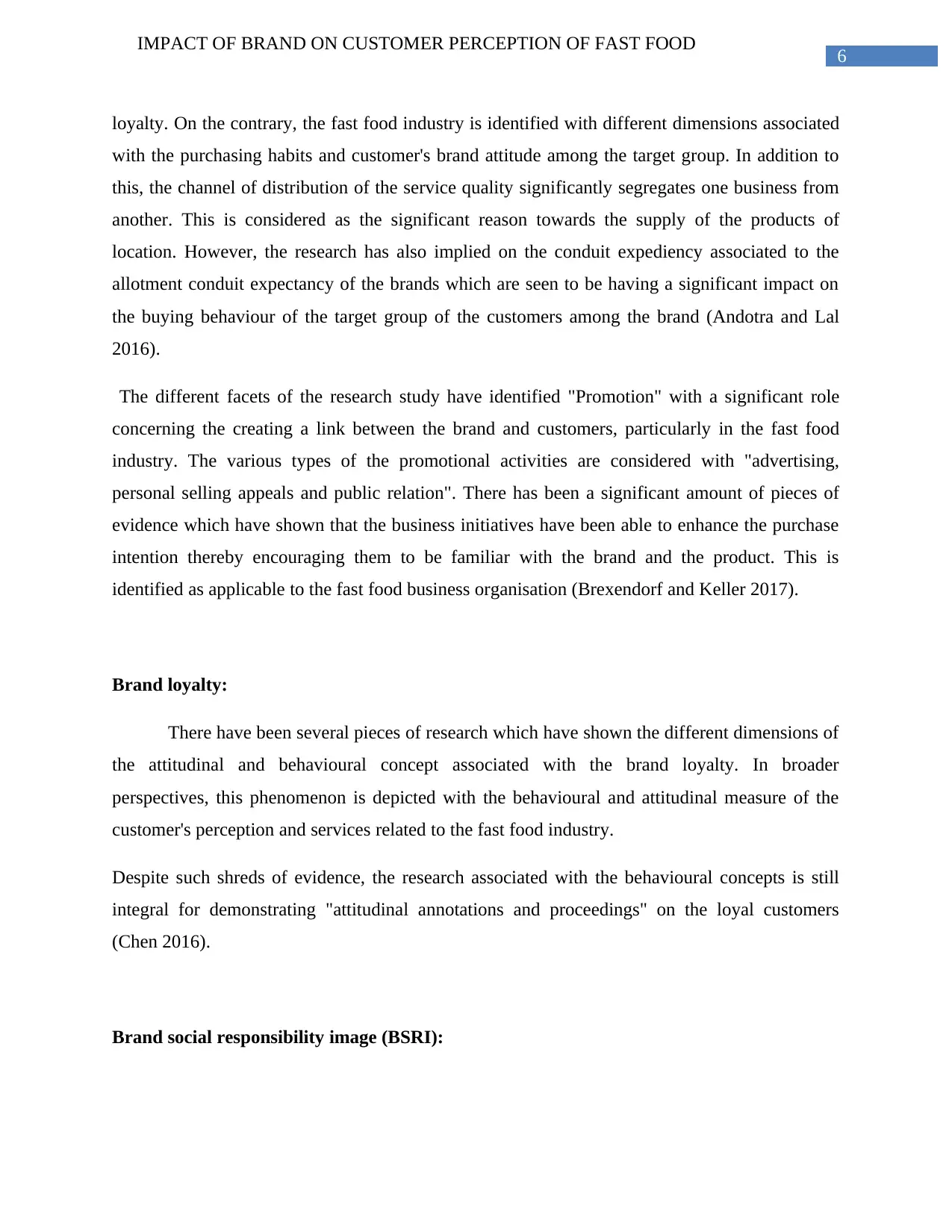
6
IMPACT OF BRAND ON CUSTOMER PERCEPTION OF FAST FOOD
loyalty. On the contrary, the fast food industry is identified with different dimensions associated
with the purchasing habits and customer's brand attitude among the target group. In addition to
this, the channel of distribution of the service quality significantly segregates one business from
another. This is considered as the significant reason towards the supply of the products of
location. However, the research has also implied on the conduit expediency associated to the
allotment conduit expectancy of the brands which are seen to be having a significant impact on
the buying behaviour of the target group of the customers among the brand (Andotra and Lal
2016).
The different facets of the research study have identified "Promotion" with a significant role
concerning the creating a link between the brand and customers, particularly in the fast food
industry. The various types of the promotional activities are considered with "advertising,
personal selling appeals and public relation". There has been a significant amount of pieces of
evidence which have shown that the business initiatives have been able to enhance the purchase
intention thereby encouraging them to be familiar with the brand and the product. This is
identified as applicable to the fast food business organisation (Brexendorf and Keller 2017).
Brand loyalty:
There have been several pieces of research which have shown the different dimensions of
the attitudinal and behavioural concept associated with the brand loyalty. In broader
perspectives, this phenomenon is depicted with the behavioural and attitudinal measure of the
customer's perception and services related to the fast food industry.
Despite such shreds of evidence, the research associated with the behavioural concepts is still
integral for demonstrating "attitudinal annotations and proceedings" on the loyal customers
(Chen 2016).
Brand social responsibility image (BSRI):
IMPACT OF BRAND ON CUSTOMER PERCEPTION OF FAST FOOD
loyalty. On the contrary, the fast food industry is identified with different dimensions associated
with the purchasing habits and customer's brand attitude among the target group. In addition to
this, the channel of distribution of the service quality significantly segregates one business from
another. This is considered as the significant reason towards the supply of the products of
location. However, the research has also implied on the conduit expediency associated to the
allotment conduit expectancy of the brands which are seen to be having a significant impact on
the buying behaviour of the target group of the customers among the brand (Andotra and Lal
2016).
The different facets of the research study have identified "Promotion" with a significant role
concerning the creating a link between the brand and customers, particularly in the fast food
industry. The various types of the promotional activities are considered with "advertising,
personal selling appeals and public relation". There has been a significant amount of pieces of
evidence which have shown that the business initiatives have been able to enhance the purchase
intention thereby encouraging them to be familiar with the brand and the product. This is
identified as applicable to the fast food business organisation (Brexendorf and Keller 2017).
Brand loyalty:
There have been several pieces of research which have shown the different dimensions of
the attitudinal and behavioural concept associated with the brand loyalty. In broader
perspectives, this phenomenon is depicted with the behavioural and attitudinal measure of the
customer's perception and services related to the fast food industry.
Despite such shreds of evidence, the research associated with the behavioural concepts is still
integral for demonstrating "attitudinal annotations and proceedings" on the loyal customers
(Chen 2016).
Brand social responsibility image (BSRI):
Paraphrase This Document
Need a fresh take? Get an instant paraphrase of this document with our AI Paraphraser
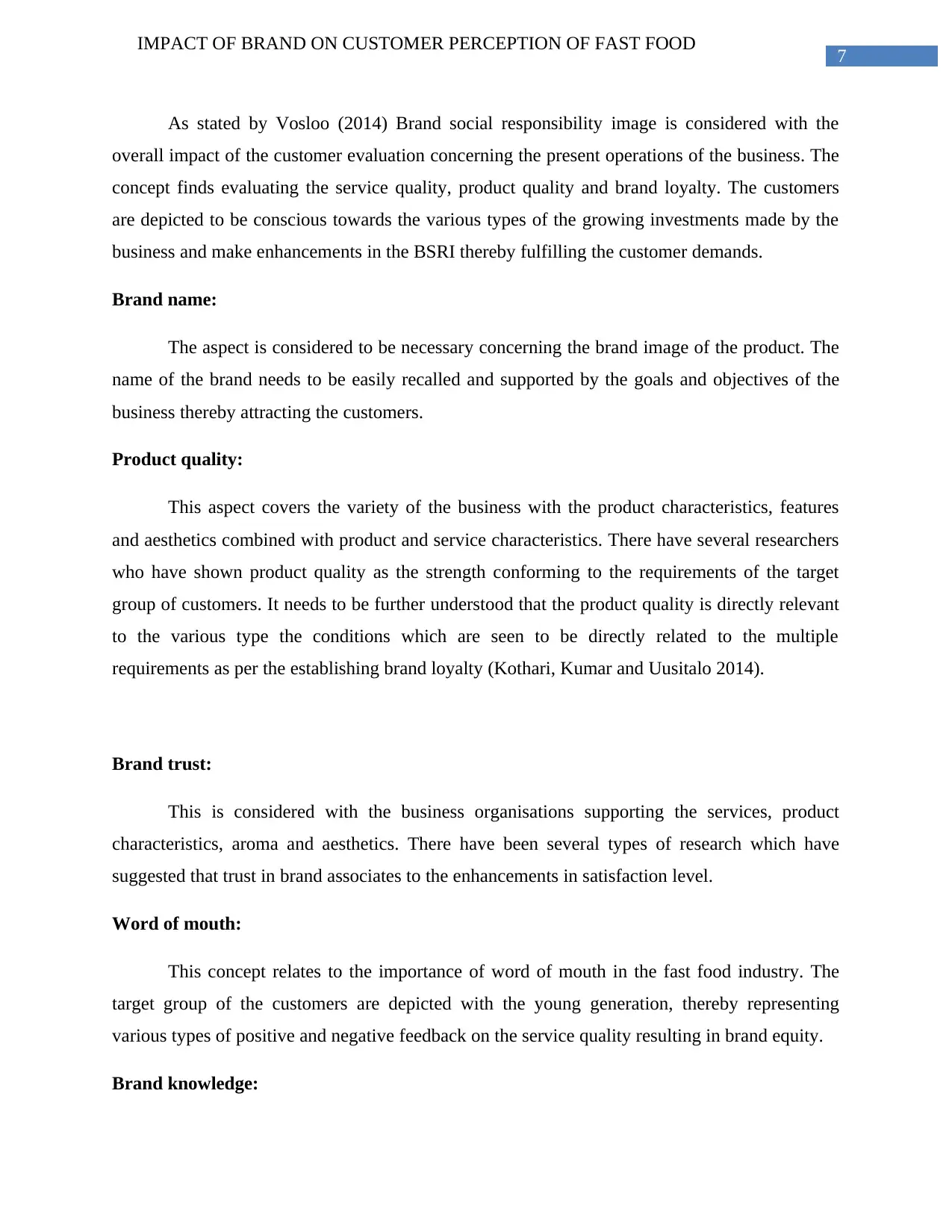
7
IMPACT OF BRAND ON CUSTOMER PERCEPTION OF FAST FOOD
As stated by Vosloo (2014) Brand social responsibility image is considered with the
overall impact of the customer evaluation concerning the present operations of the business. The
concept finds evaluating the service quality, product quality and brand loyalty. The customers
are depicted to be conscious towards the various types of the growing investments made by the
business and make enhancements in the BSRI thereby fulfilling the customer demands.
Brand name:
The aspect is considered to be necessary concerning the brand image of the product. The
name of the brand needs to be easily recalled and supported by the goals and objectives of the
business thereby attracting the customers.
Product quality:
This aspect covers the variety of the business with the product characteristics, features
and aesthetics combined with product and service characteristics. There have several researchers
who have shown product quality as the strength conforming to the requirements of the target
group of customers. It needs to be further understood that the product quality is directly relevant
to the various type the conditions which are seen to be directly related to the multiple
requirements as per the establishing brand loyalty (Kothari, Kumar and Uusitalo 2014).
Brand trust:
This is considered with the business organisations supporting the services, product
characteristics, aroma and aesthetics. There have been several types of research which have
suggested that trust in brand associates to the enhancements in satisfaction level.
Word of mouth:
This concept relates to the importance of word of mouth in the fast food industry. The
target group of the customers are depicted with the young generation, thereby representing
various types of positive and negative feedback on the service quality resulting in brand equity.
Brand knowledge:
IMPACT OF BRAND ON CUSTOMER PERCEPTION OF FAST FOOD
As stated by Vosloo (2014) Brand social responsibility image is considered with the
overall impact of the customer evaluation concerning the present operations of the business. The
concept finds evaluating the service quality, product quality and brand loyalty. The customers
are depicted to be conscious towards the various types of the growing investments made by the
business and make enhancements in the BSRI thereby fulfilling the customer demands.
Brand name:
The aspect is considered to be necessary concerning the brand image of the product. The
name of the brand needs to be easily recalled and supported by the goals and objectives of the
business thereby attracting the customers.
Product quality:
This aspect covers the variety of the business with the product characteristics, features
and aesthetics combined with product and service characteristics. There have several researchers
who have shown product quality as the strength conforming to the requirements of the target
group of customers. It needs to be further understood that the product quality is directly relevant
to the various type the conditions which are seen to be directly related to the multiple
requirements as per the establishing brand loyalty (Kothari, Kumar and Uusitalo 2014).
Brand trust:
This is considered with the business organisations supporting the services, product
characteristics, aroma and aesthetics. There have been several types of research which have
suggested that trust in brand associates to the enhancements in satisfaction level.
Word of mouth:
This concept relates to the importance of word of mouth in the fast food industry. The
target group of the customers are depicted with the young generation, thereby representing
various types of positive and negative feedback on the service quality resulting in brand equity.
Brand knowledge:
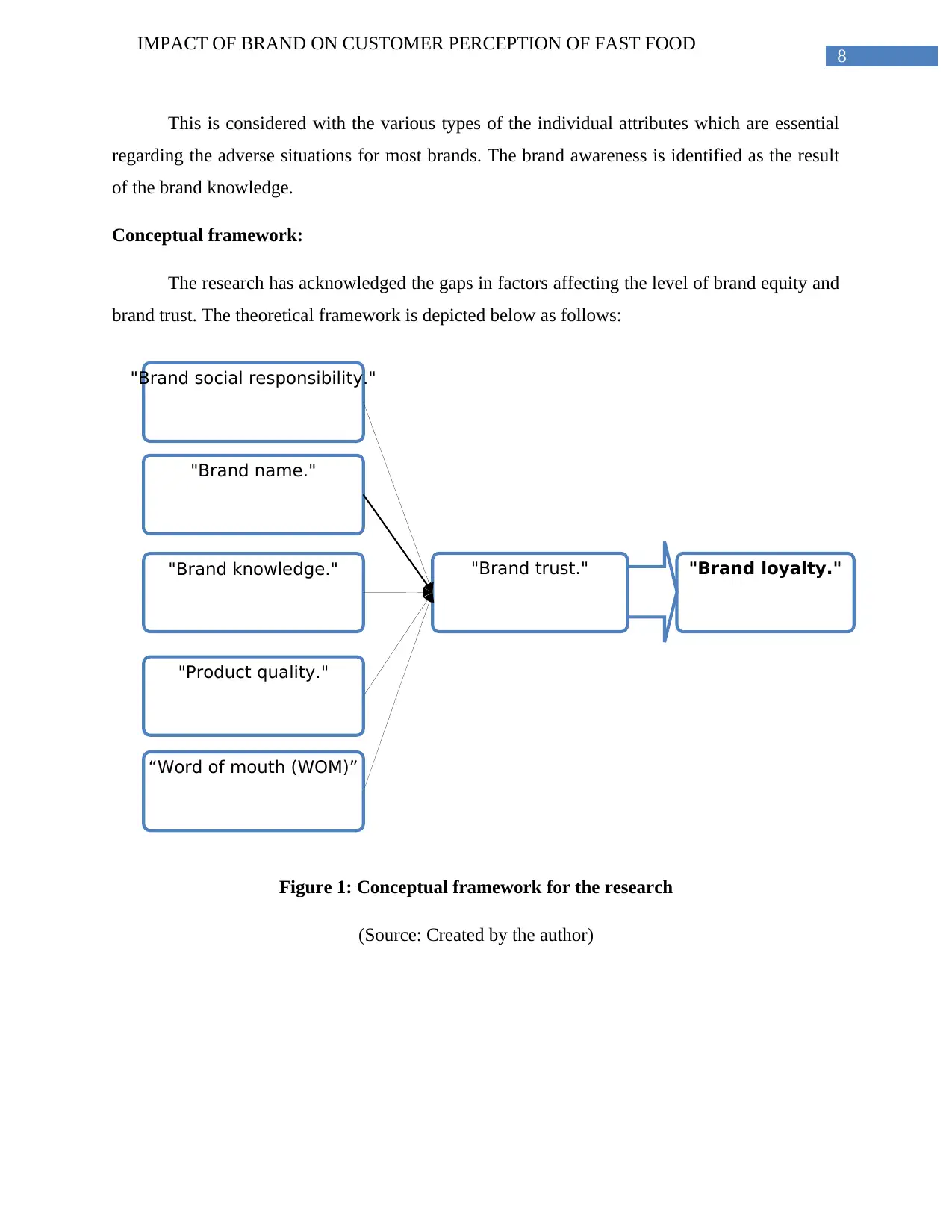
8
IMPACT OF BRAND ON CUSTOMER PERCEPTION OF FAST FOOD
"Brand social responsibility."
“Word of mouth (WOM)”
"Brand name."
"Brand knowledge."
"Product quality."
"Brand trust." "Brand loyalty."
This is considered with the various types of the individual attributes which are essential
regarding the adverse situations for most brands. The brand awareness is identified as the result
of the brand knowledge.
Conceptual framework:
The research has acknowledged the gaps in factors affecting the level of brand equity and
brand trust. The theoretical framework is depicted below as follows:
Figure 1: Conceptual framework for the research
(Source: Created by the author)
IMPACT OF BRAND ON CUSTOMER PERCEPTION OF FAST FOOD
"Brand social responsibility."
“Word of mouth (WOM)”
"Brand name."
"Brand knowledge."
"Product quality."
"Brand trust." "Brand loyalty."
This is considered with the various types of the individual attributes which are essential
regarding the adverse situations for most brands. The brand awareness is identified as the result
of the brand knowledge.
Conceptual framework:
The research has acknowledged the gaps in factors affecting the level of brand equity and
brand trust. The theoretical framework is depicted below as follows:
Figure 1: Conceptual framework for the research
(Source: Created by the author)
⊘ This is a preview!⊘
Do you want full access?
Subscribe today to unlock all pages.

Trusted by 1+ million students worldwide
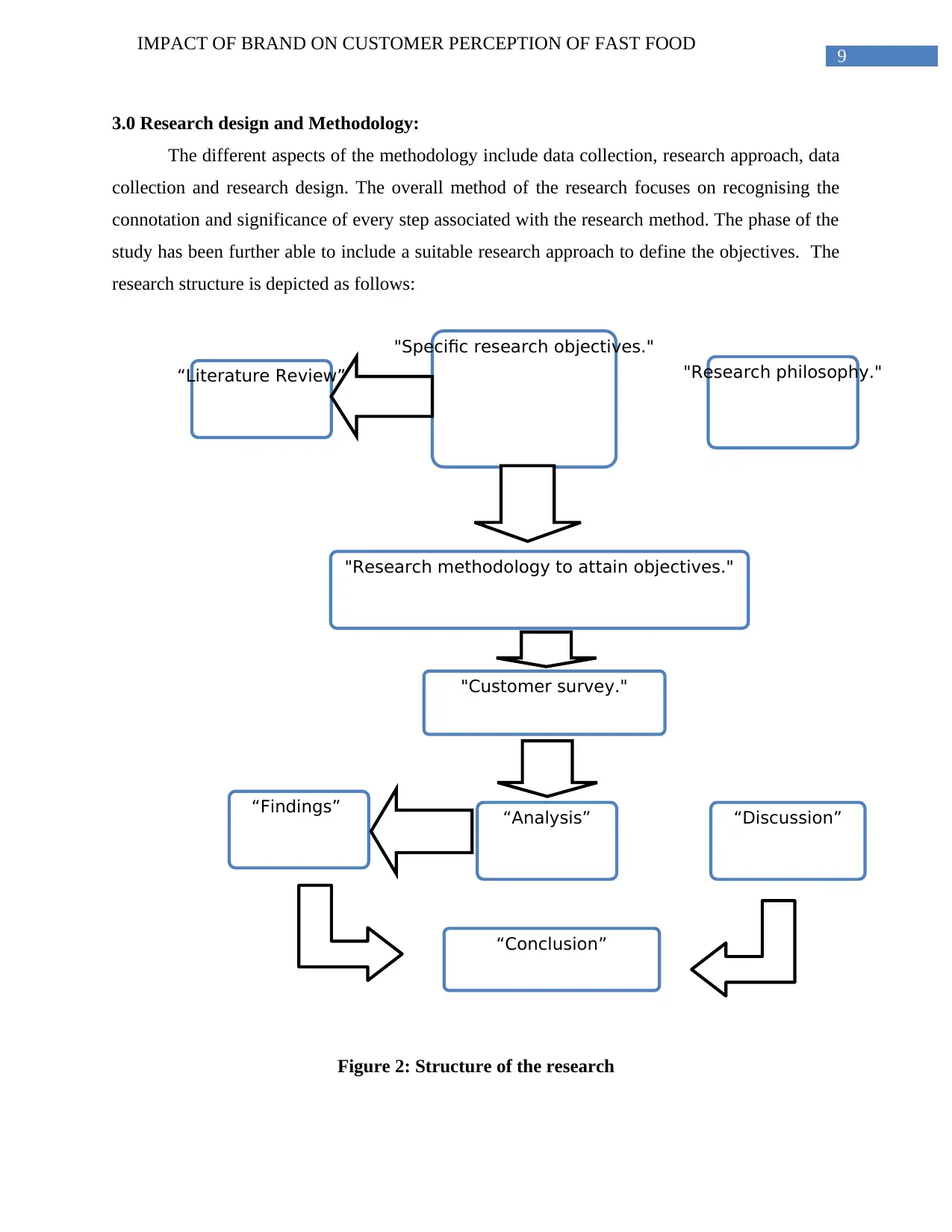
9
IMPACT OF BRAND ON CUSTOMER PERCEPTION OF FAST FOOD
“Literature Review”
"Research methodology to attain objectives."
“Analysis”
“Findings”
"Customer survey."
"Specific research objectives."
"Research philosophy."
“Discussion”
“Conclusion”
3.0 Research design and Methodology:
The different aspects of the methodology include data collection, research approach, data
collection and research design. The overall method of the research focuses on recognising the
connotation and significance of every step associated with the research method. The phase of the
study has been further able to include a suitable research approach to define the objectives. The
research structure is depicted as follows:
Figure 2: Structure of the research
IMPACT OF BRAND ON CUSTOMER PERCEPTION OF FAST FOOD
“Literature Review”
"Research methodology to attain objectives."
“Analysis”
“Findings”
"Customer survey."
"Specific research objectives."
"Research philosophy."
“Discussion”
“Conclusion”
3.0 Research design and Methodology:
The different aspects of the methodology include data collection, research approach, data
collection and research design. The overall method of the research focuses on recognising the
connotation and significance of every step associated with the research method. The phase of the
study has been further able to include a suitable research approach to define the objectives. The
research structure is depicted as follows:
Figure 2: Structure of the research
Paraphrase This Document
Need a fresh take? Get an instant paraphrase of this document with our AI Paraphraser
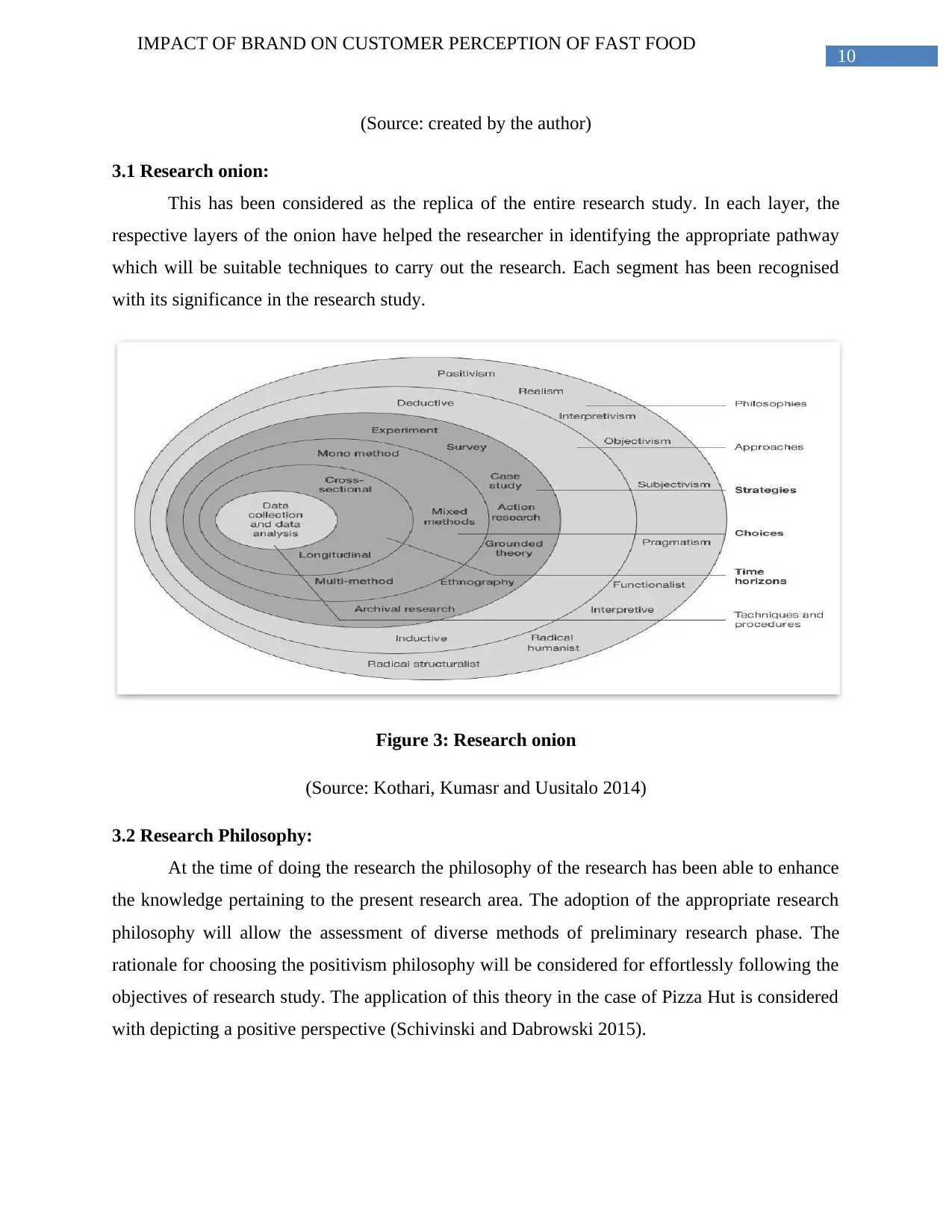
10
IMPACT OF BRAND ON CUSTOMER PERCEPTION OF FAST FOOD
(Source: created by the author)
3.1 Research onion:
This has been considered as the replica of the entire research study. In each layer, the
respective layers of the onion have helped the researcher in identifying the appropriate pathway
which will be suitable techniques to carry out the research. Each segment has been recognised
with its significance in the research study.
Figure 3: Research onion
(Source: Kothari, Kumasr and Uusitalo 2014)
3.2 Research Philosophy:
At the time of doing the research the philosophy of the research has been able to enhance
the knowledge pertaining to the present research area. The adoption of the appropriate research
philosophy will allow the assessment of diverse methods of preliminary research phase. The
rationale for choosing the positivism philosophy will be considered for effortlessly following the
objectives of research study. The application of this theory in the case of Pizza Hut is considered
with depicting a positive perspective (Schivinski and Dabrowski 2015).
IMPACT OF BRAND ON CUSTOMER PERCEPTION OF FAST FOOD
(Source: created by the author)
3.1 Research onion:
This has been considered as the replica of the entire research study. In each layer, the
respective layers of the onion have helped the researcher in identifying the appropriate pathway
which will be suitable techniques to carry out the research. Each segment has been recognised
with its significance in the research study.
Figure 3: Research onion
(Source: Kothari, Kumasr and Uusitalo 2014)
3.2 Research Philosophy:
At the time of doing the research the philosophy of the research has been able to enhance
the knowledge pertaining to the present research area. The adoption of the appropriate research
philosophy will allow the assessment of diverse methods of preliminary research phase. The
rationale for choosing the positivism philosophy will be considered for effortlessly following the
objectives of research study. The application of this theory in the case of Pizza Hut is considered
with depicting a positive perspective (Schivinski and Dabrowski 2015).

11
IMPACT OF BRAND ON CUSTOMER PERCEPTION OF FAST FOOD
3.3 Research approach:
The main research approach will be considered with following a deductive research. The
rationale for following such an approach is because it is appropriate for evaluating the current
theories set for the research. The data analysis and findings part of the research study will
confirm the relevance of the theories relating to the “relationships of brand and customer in the
fast food industry”.
3.4 Research design:
The design of the research will be seen to be suggested with establishing the main
framework for the research which is seen to be associated to the objectives set for the st udy. In
order to address these objectives, the research has been seen to be adopting a descriptive research
approach for evaluating the various aspects of brand loyalty and brand reliance with the customer
with particular consideration to fast food industry (Eckhardt and Wang 2015).
3.5 Sampling method:
The research study will state the important sampling aspects which are seen to be related
to the gathering of the primary data by conducting the survey. The plan for sampling will be
considered with the “sample procedure, sample unit and sample size”. Based on the objectives
set for the research deals with the consideration for both primary and secondary data.
Henceforth, simple random sampling has been identified as the appropriate technique to support
the objectives of the study (Kahneman 2014).
3.6 Sample size:
The study will consider a sample size of 60 respondents from the customers of the food
industry and of different age group in the field of study. The consideration of different group of
people for the study has been conducive in addressing the obtainable concepts which are
associated to reviewing the research questions (Segran 2016).
3.7 Data collection method:
Primary data collection methods:
IMPACT OF BRAND ON CUSTOMER PERCEPTION OF FAST FOOD
3.3 Research approach:
The main research approach will be considered with following a deductive research. The
rationale for following such an approach is because it is appropriate for evaluating the current
theories set for the research. The data analysis and findings part of the research study will
confirm the relevance of the theories relating to the “relationships of brand and customer in the
fast food industry”.
3.4 Research design:
The design of the research will be seen to be suggested with establishing the main
framework for the research which is seen to be associated to the objectives set for the st udy. In
order to address these objectives, the research has been seen to be adopting a descriptive research
approach for evaluating the various aspects of brand loyalty and brand reliance with the customer
with particular consideration to fast food industry (Eckhardt and Wang 2015).
3.5 Sampling method:
The research study will state the important sampling aspects which are seen to be related
to the gathering of the primary data by conducting the survey. The plan for sampling will be
considered with the “sample procedure, sample unit and sample size”. Based on the objectives
set for the research deals with the consideration for both primary and secondary data.
Henceforth, simple random sampling has been identified as the appropriate technique to support
the objectives of the study (Kahneman 2014).
3.6 Sample size:
The study will consider a sample size of 60 respondents from the customers of the food
industry and of different age group in the field of study. The consideration of different group of
people for the study has been conducive in addressing the obtainable concepts which are
associated to reviewing the research questions (Segran 2016).
3.7 Data collection method:
Primary data collection methods:
⊘ This is a preview!⊘
Do you want full access?
Subscribe today to unlock all pages.

Trusted by 1+ million students worldwide
1 out of 16
Related Documents
Your All-in-One AI-Powered Toolkit for Academic Success.
+13062052269
info@desklib.com
Available 24*7 on WhatsApp / Email
![[object Object]](/_next/static/media/star-bottom.7253800d.svg)
Unlock your academic potential
Copyright © 2020–2025 A2Z Services. All Rights Reserved. Developed and managed by ZUCOL.




